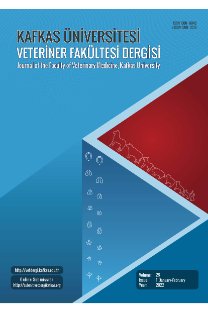Biomechanical Parameters of Asian Elephant (Elephas maximus)Walking Gait
Asya Filinin (Elephas maximus) Yürüme Biyomekanik Parametreleri
___
- Barrey E: Methods, applications and limitations of gait analysis in horses. Vet J, 157, 7-22, 1999. DOI: 10.1053/tvjl.1998.0297
- Malikides N, McGowan T, Pead M: Equine and canine lameness. In, Catherine McGowan C, Goff L, Stubbs N (Eds): Animal Physiotherapy: Assessment, Treatment and Rehabilitation of Animals. 73-101, Wiley (E-Book), 2007.
- Griffin TM, Main RP, Farley CT: Biomechanics of quadrupedal walking: How do four-legged animals achieve inverted pendulum-like movements? J Exp Biol, 207, 3545-3558, 2004. DOI: 10.1242/jeb.01177
- Biancardi CM, Minetti AE: Biomechanical determinants of transverse and rotary gallop in cursorial mammals. J Exp Biol, 215, 4144-4156, 2012. DOI: 10.1242/jeb.073031
- Genin JJ, Willems PA, Cavagna GA, Lair R, Heglund NC: Biomechanics of locomotion in Asian elephants. J Exp Biol, 213, 694-706, 2010. DOI: 1242/jeb.035436
- Hutchinson JR, Schwerda D, Famini DJ, Dale RHI, Fischer MS, Kram R: The locomotor kinematics of Asian and African elephants: Changes with speed and size. J Exp Biol, 209, 3812-3827, 2006. DOI: 10.1242/ jeb.02443
- Wijesooriya PN, Abeykoon AHS, Udawatta L, Punchihewa A, Nanayakkara T: Gait pattern analysis of an Asian elephant. IEEE 6th International conference on Information and Automation for Sustainability (IcIAfS), 27-29 Sep., Beijing, China, 221-226, 2012.
- Hutchinson JR, Famini D, Lair R, Kram R: Biomechanics: Are fast moving elephants really running? Nature, 422, 493-494, 2003. DOI: 1038/422493a
- Heglund NC, Taylor CR: Speed, stride frequency and energy cost per stride: How do they change with body size and gait? J Exp Biol, 138, 301- , 1988.
- Hildebrand M: Rotations of the leg segments of three fast running cursors and an elephant. J Mammal, 65, 718-720, 1984. DOI: 2307/1380866
- Klinhom S, Chaichit T, Nganvongpanit K: A comparative study of range of motion of forelimb and hindlimb in walk pattern and trot pattern of Chihuahua dogs affected and non-affected with patellar luxation. Asian J Anim Vet Adv, 2015. DOI: 10.3923/ajava. 247.259
- Alexander RM: Energy-saving mechanisms in walking and running. J Exp Biol, 160, 55-69, 1991.
- Biewener AA: Patterns of mechanical energy change in tetrapod gait: Pendula, springs and work. J Exp Zool, 305A, 899-911, 2006. DOI: 1002/jez.a.334
- Cavagna GA, Heglund NC, Taylor CR: Mechanical work in terrestrial locomotion: Two basic mechanisms for minimizing energy expenditure. Am J Physiol, 233, R243-R261, 1977.
- Kuo AD: The six determinants of gait and the inverted pendulum analogy: A dynamic walking perspective. Hum Movement Sci, 26, 617-656, DOI: 10.1016/j.humov.2007.04.003
- Ren L, Butler M, Miller C, Paxton H, Schwerda D, Fischer MS: The movements of limb segments and joints during locomotion in African and Asian elephants. J Exp Biol, 211, 2735-2751, 2008. DOI: 10.1242/ jeb.018820
- Haakonsson JE and Semple S: Lateralisation of trunk movements in captive Asian elephants (Elephas maximus). Laterality, 14, 413-422, 2009. DOI: 10.1080/13576500802572442
- ISSN: 1300-6045
- Yayın Aralığı: 6
- Başlangıç: 1995
- Yayıncı: Kafkas Üniv. Veteriner Fak.
Zhitao WANG, Jungang WANG, Yongsheng ZHANG, Xudong WANG, Xiaoli ZHANG, Yu LIU, Jifeng XI, Hao TONG, Qiaoli WANG, Bin JIA, Hong SHEN
Huan ZHANG, Liping GUO, Qingqing WEI, Ke ZHANG, Shanahan ZHAO, Hongyu LI, Chuangfu CHEN, Wanjiang ZHANG, Yali ZHANG, Yuanzhi WANG
Ayşe EKEN, Orhan YÜCEL, İFFET İPEK BOŞGELMEZ, AYŞE BALDEMİR KILIÇ, Sezai ÇUBUK, Ali Hakan ÇERMİK, Burcu ENDİRLİK ÜNLÜ, Elçin BAKIR, Akın YILDIZHAN, Adem GÜLER, MÜBERRA KOŞAR
Le-Ying ZHANG, Pei-Bin QU, Yan TU, Chun-Tao YANG, Qi-Yu DIAO
Corneal Impression Cytology for the Diagnosis of Limbal Stem Cell Deficiency in a Dog
F. Eser ÖZGENCİL, Nurhayat GÜLMEZ, Çağrı GÜLTEKİN, Serkan SAYINER
Asghar GHAHREMANI, Ali Asghar SADEGHI, Saeed HESARAKI, Mohammad CHAMANI, Parvin SHAWRANG
Biomechanical Parameters of Asian Elephant (Elephas maximus)Walking Gait
Siriphan KONGSAWASDI, Sittidej MAHASAWANGKUL, Pornsawan PONGSOPAWIJIT, Kajornphat BOONPRASERT, Busaba CHUATRAKOON, Nipaporn THONGLORM, Rungtiwa KANTA-IN, Tanapong TAJARERNMUANG, Korakot NGANVONGPANIT
Wenyan GAI, Junwei WANG, Juan WANG, Zhigang CUI, Zhina QU, Yundong WANG, Jun HONG, Jinghua CUI, Shigan YAN, Xiaoli DU, Xiumei HUANG, Jianmei ZHAO, Liping ZHU
Surgical Treatment of Dorsal Scapular Luxation in Cats: Six Cases (2010-2016)
KÜRŞAT ÖZER, MURAT KARABAĞLI, Haluk ÖMER, Muhammet Eyüp DEMİR
